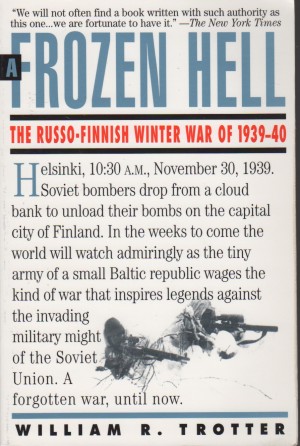
Frozen Hell by William R. Trotter(1991. Algonquin. ISBN 1565122496)
When my old scoutmaster Arnie Erickson passed away, he left a legacy of service to youth, his church, his family, and his community. He also left William Trotter’s scholarly treatment of Finland’s titanic struggle with Communist Russia during the winter of 1939-1940, Frozen Hell, which his daughter Jan passed on to me because of my affinity for all things Finnish and the fact that my current writing project (Sukulaiset: The Kindred) incorporates the Winter War into its storyline. Despite my love for Arnie and the subject matter, I was a bit reluctant to dive into the book, mostly because I’d completed my research, had just finished a couple of non-fiction books for pleasure (I like to switch my reading between non-fiction and fiction to keep things lively), and, to be truthful, I was sort of “finished” with all things Finnish as they relate to the manuscript. But in deference to my friend and her departed father, I cracked the spine on Trotter’s work and I am glad I did.
Similar in tone and pace and authority to Henrik Lunde’s Finland’s War of Choice, a more recent (2011) look at the Continuation War (the war in Finland which followed the Winter War) Frozen Hell is well organized, detailed, and thoroughly researched. Folks who have read Talvisota (The Winter War) Antii Turri’s gripping novel covering the same time period and topic, and who reveled in the exposition of character good fiction allows, will find only small doses of similar revelation in Trotter’s more staid and scholarly work. Trotter does give us a fairly thorough and, despite the author’s obvious fondness for the Finns and their sisu, honest biographical of the leading Finnish military figure of the era, Karl Mannerheim. There are briefer, more cursory histories of minor officers and politicians as well, all of which add flavor and color to the facts of war. One ancillary protagonist who Trotter spends a bit of time discussing near the book’s conclusion is Life Magazine photo journalist, Carl Mydans, a figure I’d come across while searching for a photograph to use as the cover for Sukulaiset. Mydans is a remarkable figure in the history of modern photography. Collections of his work are held by Stanford and other prestigious institutions. Mydans, along with his wife Shelley (also a professional photographer), covered World War II for Life in Finland and China. Intriguingly, Trotter actually ends his rendition of this epic David versus Goliath struggle with a scene where Mydans is identified by Finnish soldiers as an American, who then proceed to confront Mydans. I won’t spoil the ending here but, suffice it to say, Trotter’s treatment of Mydans, as brief as it is in this non-fiction dissection of the Winter War, is so compelling, it begs a full-blown biography of Mydans’s remarkable life and career. Similarly, when the author laments that no one has produced a well-written English language biography of Mannerheim, (who is, arguably next to composer Jean Sibelius, Finland’s most famous person) I paused and thought:
Hey. You’re an excellent writer. Why don’t you pick up your own challenge and the Field Marshall’s life story?
Trotter is a master of revelation and detail, which, at times, can lead to the reader being inundated with facts, searching for the thread of story. But the author is assertively blunt in debunking the claim that many Finns are prone to invoke: That while Finland didn’t defeat Stalin’s hordes, it certainly did fight the Russian Bear to a standstill, causing The Soviet Union to sue for a less attractive peace. Though he heaps praise on the Finnish fighters, who, with scant air support and virtually no armor, did indeed stand toe-to-toe with a far superior enemy, and, as in the chapter depicting Finland’s greatest victory during the short-lived conflict (the battle of Suomussalmi where small units of Finns on skis encircled and wiped out far larger Russian divisions, leading to the summary execution of the Russian commanders when they fled), Trotter lays down the law with respect to the legends of Finnish victory. The end result of the four months of fighting known as the Winter War was, at best, a dress rehearsal for a larger, more violent conflict that would begin less than two years after the ink was dry on the armistice between the Finns and their neighbor to the east. And the end result of the celebrated Winter War, which saw the Finns reeling back towards Helsinki in near collapse, was nowhere near a military “victory” for the beleaguered Finns. Did the fight prove the measure of Finnish resolve? Surely. Was the Winter War a warning to Stalin that, if he wished to reclaim Finland as part of his empire, more blood would spill? Absolutely. But a victory for the Finns? Trotter debunks that myth with a mountain of evidence in this fine effort.
4 and 1/2 stars out of 5.
Peace.
Mark
PS Unable to obtain permission to use Mydans’s work, I located an excellent repository of war photographs depicting the entire Finnish/Russian conflict from 1939-1944. The Finnish Defense Forces maintain an archive of such work, free and reproducible to the public, at http://sa-kuva.fi/. The photo I finally settled on to be the cover art for Sukulaiset can be found below. I hope you agree it is an extremely powerful image.
MM




Hi Mark,
I enjoyed your review of Arne’s book, very insightful. I’m glad you found time to read and review it. Wish Arn could read this.
Jan
Oh but Arne is reading it and smiling! Thanks.
MM